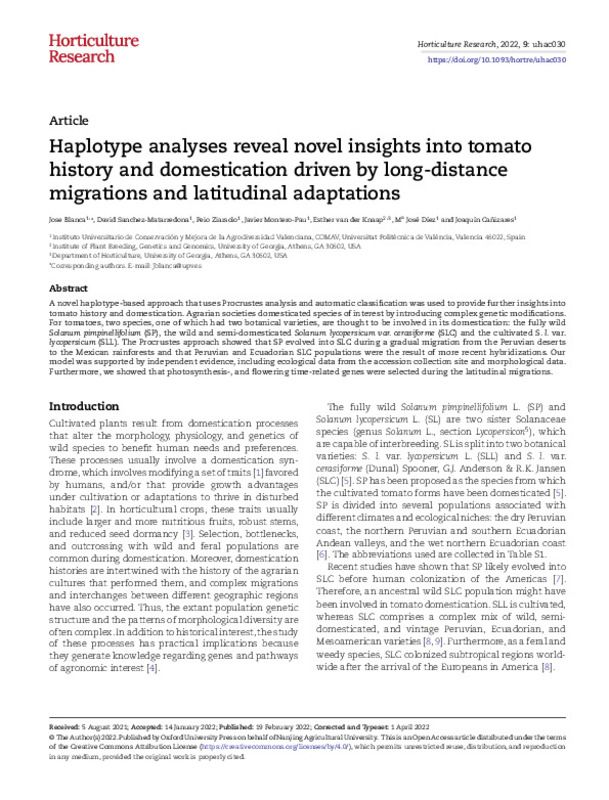JavaScript is disabled for your browser. Some features of this site may not work without it.
Buscar en RiuNet
Listar
Mi cuenta
Estadísticas
Ayuda RiuNet
Admin. UPV
Haplotype analyses reveal novel insights into tomato history and domestication driven by long-distance migrations and latitudinal adaptations
Mostrar el registro sencillo del ítem
Ficheros en el ítem
| dc.contributor.author | Blanca Postigo, José Miguel
|
es_ES |
| dc.contributor.author | Sánchez-Matarredona, David
|
es_ES |
| dc.contributor.author | Ziarsolo, Pello
|
es_ES |
| dc.contributor.author | Montero-Pau, Javier
|
es_ES |
| dc.contributor.author | van der Knaap, Esther
|
es_ES |
| dc.contributor.author | Díez Niclós, Mª José Teresa De Jesús
|
es_ES |
| dc.contributor.author | Cañizares Sales, Joaquín
|
es_ES |
| dc.date.accessioned | 2023-10-20T18:00:49Z | |
| dc.date.available | 2023-10-20T18:00:49Z | |
| dc.date.issued | 2022-01-05 | es_ES |
| dc.identifier.uri | http://hdl.handle.net/10251/198493 | |
| dc.description.abstract | [EN] A novel haplotype-based approach that uses Procrustes analysis and automatic classification was used to provide further insights into tomato history and domestication. Agrarian societies domesticated species of interest by introducing complex genetic modifications. For tomatoes, two species, one of which had two botanical varieties, are thought to be involved in its domestication: the fully wild Solanum pimpinellifolium (SP), the wild and semi-domesticated Solanum lycopersicum var. cerasiforme (SLC) and the cultivated S. l. var. lycopersicum (SLL). The Procrustes approach showed that SP evolved into SLC during a gradual migration from the Peruvian deserts to the Mexican rainforests and that Peruvian and Ecuadorian SLC populations were the result of more recent hybridizations. Our model was supported by independent evidence, including ecological data from the accession collection site and morphological data. Furthermore, we showed that photosynthesis-, and flowering time-related genes were selected during the latitudinal migrations. | es_ES |
| dc.description.sponsorship | This research was supported by the National Natural Science Foundation of the USA Varitome Project (NSF IOS 1564366). | es_ES |
| dc.language | Inglés | es_ES |
| dc.publisher | Springer Nature | es_ES |
| dc.relation.ispartof | Horticulture Research | es_ES |
| dc.rights | Reconocimiento (by) | es_ES |
| dc.subject.classification | GENETICA | es_ES |
| dc.title | Haplotype analyses reveal novel insights into tomato history and domestication driven by long-distance migrations and latitudinal adaptations | es_ES |
| dc.type | Artículo | es_ES |
| dc.identifier.doi | 10.1093/hr/uhac030 | es_ES |
| dc.relation.projectID | info:eu-repo/grantAgreement/NSF//NSF IOS 1564366/ | es_ES |
| dc.rights.accessRights | Abierto | es_ES |
| dc.contributor.affiliation | Universitat Politècnica de València. Escuela Técnica Superior de Ingeniería Agronómica y del Medio Natural - Escola Tècnica Superior d'Enginyeria Agronòmica i del Medi Natural | es_ES |
| dc.contributor.affiliation | Universitat Politècnica de València. Instituto Universitario de Conservación y Mejora de la Agrodiversidad Valenciana - Institut Universitari de Conservació i Millora de l'Agrodiversitat Valenciana | es_ES |
| dc.description.bibliographicCitation | Blanca Postigo, JM.; Sánchez-Matarredona, D.; Ziarsolo, P.; Montero-Pau, J.; Van Der Knaap, E.; Díez Niclós, MJTDJ.; Cañizares Sales, J. (2022). Haplotype analyses reveal novel insights into tomato history and domestication driven by long-distance migrations and latitudinal adaptations. Horticulture Research. 9:1-14. https://doi.org/10.1093/hr/uhac030 | es_ES |
| dc.description.accrualMethod | S | es_ES |
| dc.relation.publisherversion | https://doi.org/10.1093/hr/uhac030 | es_ES |
| dc.description.upvformatpinicio | 1 | es_ES |
| dc.description.upvformatpfin | 14 | es_ES |
| dc.type.version | info:eu-repo/semantics/publishedVersion | es_ES |
| dc.description.volume | 9 | es_ES |
| dc.identifier.eissn | 2052-7276 | es_ES |
| dc.identifier.pmid | 35184177 | es_ES |
| dc.identifier.pmcid | PMC8976693 | es_ES |
| dc.relation.pasarela | S\471092 | es_ES |
| dc.contributor.funder | National Science Foundation, EEUU | es_ES |








